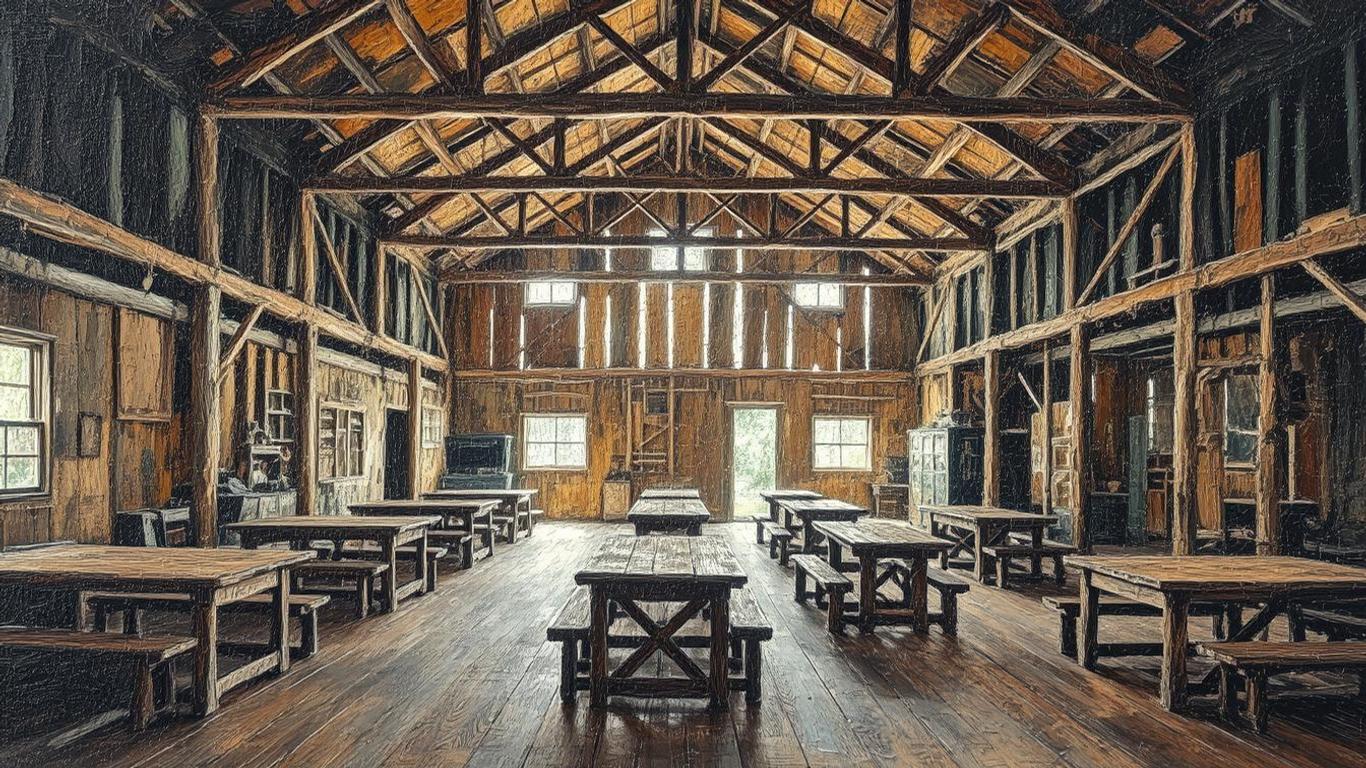Arrival at Stone Creek
Every arrival is the same, but no two are alike.
Nearly all children and teenagers who come to Stone Creek Ranch do so after a traumatic event. Whether they've lived their life in the foster care system, have recently lost a parent, were referred by their mental-health specialist, or were arrested for committing a minor crime, as Malone says to every new member of the staff, "These kids come scared."
The Stone Creek approach is to ensure that every student arriving on the ranch is welcomed with kindness, compassion, and acceptance. The arrival process has become a tradition, of sorts, designed by repetition to ensure that the students feel secure in what will likely be their new home for four or more years.
While the staff emphasizes the importance of community life and cooperation on the ranch, it is essential to treat each student as unique. Staff do not deviate from the prescribed ritual of arrival unless absolutely necessary ("every arrival is the same"), but because each student is a unique individual with a unique history and needs, staff are trained to focus on the student more than on the ritual ("no two are alike").
Upon arrival students check in with a transition specialist whose job it is to help them settle into their new life at Stone Creek. This highly-trained social worker will remain their primary point of contact for the first two weeks of their time in the program and will check in with them every day to make sure they are settling in and gaining confidence. Their appointment may be extended as necessary for up to six weeks for students struggling to settle in.
Check In Process
Each student's experience at Stone Creek Ranch begins with a check-in that will familiarize them with the ranch and the ranch's staff (their transition specialist) with them and their needs. This process forms the foundation of their experience and sets them up to succeed in working the program until they hopefully graduate. This is the first part of what is considered the Admit (or Admissions) process and it constitutes the first part of a ritual repeated (almost verbatim) with each student as they arrive.
Here, we will go step-by-step through the process.
Initial Introductions
During the initial introduction, the transition specialist will introduce themselves to the new student by their first and last name, encouraging the student to use their first name as is expected for all members of the staff except for the teaching or medical faculty (who are referred to as Dr., Ms., or Mr. Surname as appropriate). The transition specialist will confirm the student's name and date of birth at this juncture, then resume referring to the student by the student's surname, as is the convention for Stone Creek Ranch.
Next, the transition specialist will instruct the new student in the Rules of the Ranch and provide them with a handbook they can use to reference when they are in doubt. If the student has any questions, at this point the transition specialist opens the floor to answer questions the student has and to provide answers they can or references to another adult if they cannot.
When the introductions are over, it is time for the transition specialist to take a medical history of the student.
Medical History
While the ranch has access to a student's medical history due to the various paperwork required to attend the school, it is important for the transition specialist (and then afterward the doctor or nurse) to obtain a medical history in the student's own words. This helps the staff to know how the student understands their own health as well as to observe the student's behavior surrounding some of the important questions about alcohol and drug use, sexual experience, and history of abuse. Transition specialists are trained to note deviations and to provide the therapy team with necessary information to help support the student through their time on the ranch.
Students may be reluctant to participate and cooperate with this part of the interview because they fear that they will be judged or punished for their past behavior. It is up to the transition specialist to reassure the new student that this is not the case and that they only want to know how they can best help the student. When a student is currently using drugs or engaging in disordered eating at the time of admission, their treatment plan is vastly different than if they are not, as the ranch's medical staff works to help mitigate the effects of withdrawal or re-feeding.
Medical Examination
Once the medical history has been taken directly from the student, the transition specialist will lead the student to the examination room in the admissions building, where one of the ranch's nurses (usually) or doctors (rarely) will perform a routine physical during which they will repeat many of the same questions the transition specialist has already asked. The student is expected to strip for this examination so that the nurse can take an inventory of any marks on the student's body at the time of arrival. If there has been apparent abuse, it will be reported to the authorities to investigate. If there are signs of self-harm, this will be noted in the file so that the therapy staff can begin treatment with the student.
Medical staff is patient and will always wait for the student's cooperation before proceeding, even if it takes hours to complete the process of administering the physical. Staff is trained to be hands-off with agitated students. (The general rule is for staff to remain hands-off at all times, but this does not prevent staff from providing physical comfort for students who are in distress and may need a hug.)
Belongings Search
While the student is with the nurse or doctor, the transition specialist must search their belongings. The process takes place without the student present because it can be upsetting for the student, but it was not always done this way, and this practice is still subject to change. Belongings are searched in an effort to reduce contraband materials on the ranch and to limit the exposure by other students to any drugs or weapons arriving on the ranch. About 1/3 of all students attempt to bring something they aren't supposed to, and of those 1/3 about 1/2 are drugs. Other contraband nearly always consists of makeup and other personal care items -- most often razors.
Contraband is then confiscated and everything else is returned to the bags to be returned to the students.
The Uniform
During the physical examination, when it is time for the student to dress, the nurse or doctor will give the student their new uniform, which consists of either a t-shirt or a hoodie (depending on the season) in the color of their group (shown to the right is the dark green Wellwader uniform), a pair of blue jeans, and a pair of hiking boots. Other items for the Student's Kit are already in the student's dresser in their Dormitory Cabin.
The arrival to Stone Creek is counted as the beginning of a new life, a renewal most students didn't think was possible.
Group Assignment
Following the check-in process, the transition specialist will introduce the student to their new group. This begins with talking about the name of the group, the group's unique culture, and where to find the group's dormitories. The initial information provided by the Transition Specialist prepares the student to integrate with their group as smoothly as possible. This is often the most stressful part of arrival as students adjust to new personalities and the expectations of their group's counselors and leaders.
Meeting the Group
Once the oral part of the introduction is done, the student will have the opportunity to meet whichever of their group's counselors is currently on duty.
This can be confusing for new students, who may understand counselors either to mean they are in some kind of a "stay away camp" or that these are the people who will be acting as their therapists and that they are in a mental health facility.
While this may be an improvement for those who fear they have been sent to a correctional facility (at least for some!), neither of these are accurate interpretations. The Counselors act in a similar capacity to camp counselors, but Stone Creek is not a camp. They are not therapists and this is not a mental health facility, but therapists work with students twice per week (once one on one and once in support group). Counselors do facilitate daily group therapy.
Introduction to the Dorms
The transition specialist will, at this point, transfer the student to the Counselor they have now met, and the counselor will take over for a short period. The counselor's job during the admit process is to introduce the new student to their living environment (their dormitory cabin, their bed, and their mailbox) and to show them where they can find the Mess Hall.
Once the student has been shown these key locations, they are left to unpack their things and set up their dormitory area in accordance with the ranch's policies, which are based on the Level the student has achieved. (All students start out as a Mustang unless they are returning following an expulsion, in which case they are considered an Outlaw.)
That first hour alone in the dorms is when it really all starts to sink in. But the kids only think they're alone. We're right outside if they need us.
A Few Surprises
Stone Creek has in store for its students a few surprises they typically don't expect. It's not so much that the philosophies of the ranch are kept under strict confidence as it is that the social workers bringing the students to the ranch don't always give the information they have to the new student. It's far from fair, but most students enjoy the surprises and those who don't are given time to adjust.
Learning the Structure of Activities
Students arrive with the understanding they are going to be attending a school in Montana designed to handle troubled adolescents with behavioral issues. While this is not an accurate description of the ranch, it is the most commonly propagated, meaning that those who have never been there often treat it as another Residential Treatment Center for teens. Considering all that entails, many students arrive terrified and with expectations of strict, unbearable regimens and harsh punishments for failure to adhere to the structure laid out for them.
While Stone Creek's structure is, indeed, regimented, the Schedule has been structured in a way that encourages learning, ensures adequate rest time, and provides wholesome, delicious meals for the students with a maximum of encouragement and a minimum of punishment.
The First Hour
The first hour of the morning is spend doing chores. Most groups will complete their chores before the hour is over, but the hour provides sufficient time for the group cooking breakfast to finish their cooking lesson before the rest of the school settles down to eat. Students and groups who finish their chores before breakfast is finished may take free time to relax, socialize with students outside of their groups, or catch up on any school work.
Breakfast
Breakfast is served promptly at 7 a.m. in the morning, and always consists of wholesome options. Most students are surprised to learn that the options change from day to day and that while they always offer a protein, a fruit or vegetable, and a grain, the variety and the choices offered each day are incredible, also providing an incredible education in food management for the group doing the cooking each meal. Please see the example to the left, which, even if poorly drawn by AI, is a rough representation that consists of a large slice of quiche (protein and vegetable), fried tomatoes, a muffin, and apparently a cookie. Also provided are overnight oats, orange juice, and milk.
(Please forgive this author, who will not simply rip images off of recipe websites, for not knowing how to describe the concept of "hash browns" to Gencraft. The results were disgusting and unpalatable.)
School
The school day begins at 8 a.m. and ends at 11 a.m. This comes as quite a shock to the majority of students, most of whom were expecting to endure hours of rigorous school work in the form of drills and other standard educational practices. Instead, the new student is always informed that school takes place in the field on warm days and in one of the converted barns on the cool days. Most are surprised when they see the classrooms for the first time, as they often consist of comfortable chairs positioned in a circle so the teacher can speak up close to each of the students, instructing them on their level.
Between the end of the school day and lunch, the students who are not preparing lunch have an hour of free time and are encouraged to use this free time to do any chores they couldn't get done in the morning, to work on any (usually minor) homework their teachers sent back with them, or to socialize with students who are not part of their group.
Lunch works similarly to breakfast, and therefore most transition specialists, when describing the process, gloss over the lunch and dinner periods. Like anyone, they want to get to the fun stuff. And this is often where this part of the introduction ends, because most social workers know how to explain the rest while giving the students what is often the shock of their life.
The Big Reveal
This is the point at which the transition specialist leads the student to one of the four main barns and takes them inside. Since the student has already been shown the dorm rooms and has the general sense of the mess hall and the school area (both converted barns), they often expect to be shown another conversion. Instead, they are greeted with the distinct scent of hay and horse dung (a sweet smell to those who love horses, repulsive to those who do not).
Stone Creek, the transition specialist explains, is not just a boarding school. In fact, the ranch started out as a rescue center in the 90s, taking in horses who had been abandoned by those who could no longer afford them during the recession and supported by what a lot of people in the town of Blue Lake think of as Magic Money. Part of a student's responsibility while at Stone Creek is to care for one of the rescued horses, all of which have been abandoned or abused and who come from a number of different breeds, each matched by personality to the student who will care for them.
This horse will be with the student at least for the length of their time at Stone Creek, but often for the rest of the horse's life, as students are encouraged to return for their horse when they finish college.
Equine Therapy is the cornerstone of treatment at Brook Haven Ranch, and the students learn early that their afternoons will be spent working in horsemanship and then learning to ride.
Next Steps
Beyond this point, the transition specialist accompanies the student to the mess hall for their first meal on the ranch. Most times this will be lunch, but occasionally the student will arrive after lunch and therefore the first full meal will be dinner. In the mess hall, the transition specialist introduces the student to the other students in their group, ensures that they have been welcomed, and then leaves the student with their group to select their options from the cafeteria window and join their new group to eat. The specialist will, of course, always remain close to ensure that everything goes smoothly.
With this integration to the group, the beginning of the ritual has taken place. The transition specialist will continue to follow up with the student for the next two to six weeks, checking in every morning for an update on how things are going and ensuring that things are transitioning smoothly.
Every student deserves a completely fresh start. That's why we start them off at the same level and encourage the to work together from day one.
From the Author
Stone Creek remains, as it always has been, a labor of love and an attempt to bring the wonderful person I know as Logan Brook (who seemingly exists only in my own mind) to other people who could and should know him. This labor of love is also an act of courage, bringing to life and sharing with others something that is so precious to me. In writing this, Stone Creek here on World Anvil has become my own "Ritual of Renewal."
It's time I dust off that old novel and start revising again.
Thank you for reading, and remember: Comments are currency! I'd love to know what you thought of this article and what you'd like to see more of in the future.
These kids come scared.
Students are always offered a snack during their admit. This is often something sweet offered alongside a salty snack for those who prefer not to eat too much sugar.
This also provides the students an introduction to the type of food they can expect at Stone Creek.
The food at Stone Creek exceeds expectations.


















Comments